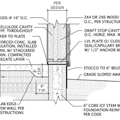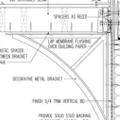How to insulate a old Victorian home?
I have an old Victorian two-story home that I want to vinyl side, the insulation in the walls is probably lacking. My plan is to remove the cedar lap siding and investigate what is in the wall cavity and then add blown-in insulation to the wall. After that is complete cover the home with 1″ poly and Tyvek. What is the proper way to install the Tyvek — on the inside of the poly or outside? Also if there is a better way to tighten up the home I would appreciate any info.
GBA Detail Library
A collection of one thousand construction details organized by climate and house part









Replies
Ryan,
I'm not sure what you mean by "1-inch poly." In most cases, the word "poly" refers to polyethylene sheeting, which can be purchased in 4-mil or 6-mil thicknesses.
If you are thinking of 1-inch rigid foam, you're probably talking about expanded polystyrene (EPS), extruded polystyrene (XPS), or polyisocyanurate.
To answer your last question first — Is there a better way to tighten up the home? — the answer is yes. For most people, "tightening up the home" refers to air sealing. You should contact a home performance contractor to perform an energy audit; in an old Victorian home, there's a good chance you need blower-door-directed air sealing. Much of this work will be performed in the basement and attic.
Finally, concerning Tyvek: the main purpose of Tyvek is to act as a water-resistant barrier (WRB). It must be integrated with the window and door flashing, and be properly lapped. If you choose to use Tyvek, it should probably go on top of the rigid foam — although this is not a hard-and-fast rule. It can go under the foam, as long as it has been properly integrated with the flashing.